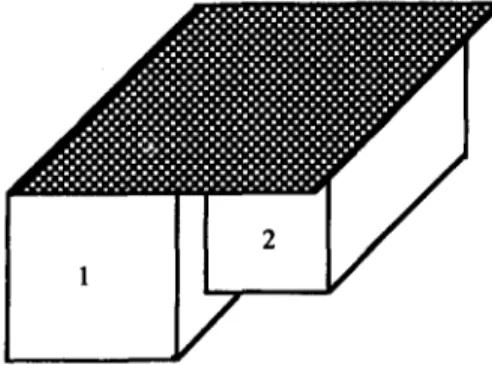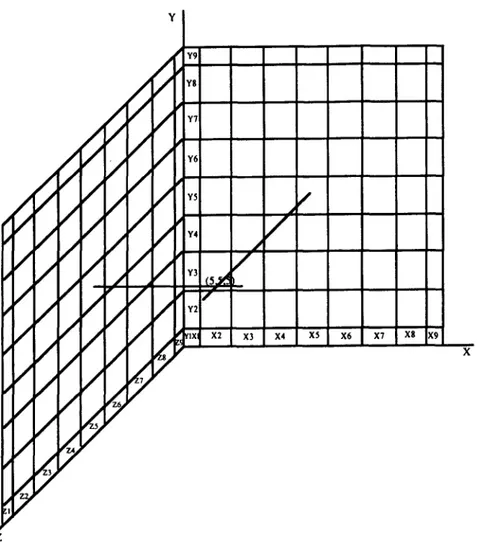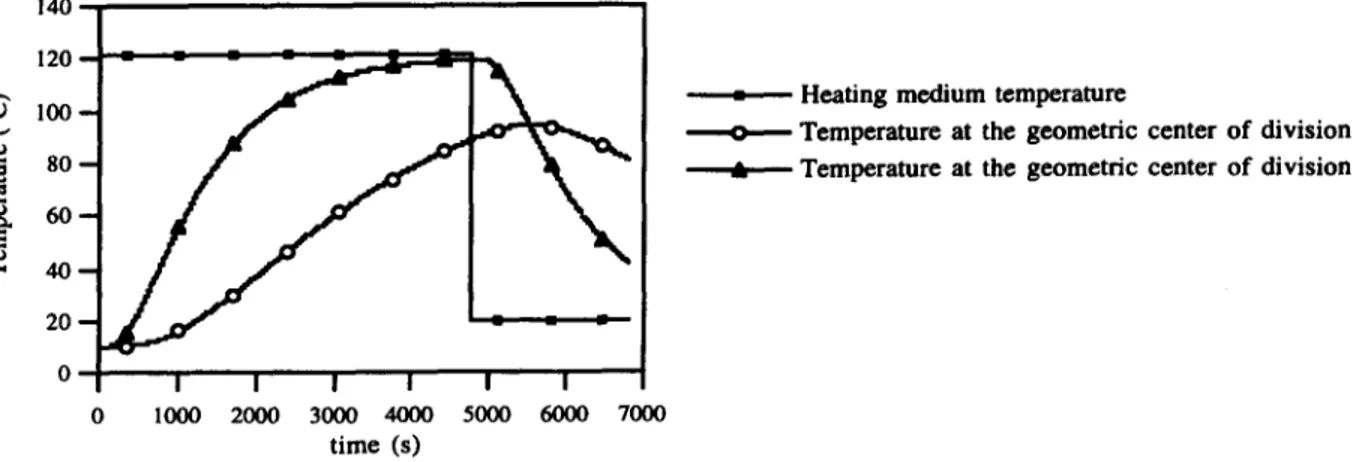Modelling the thermal sterilisation of foods inside packs with two
divisions
Isabel M.L.B. Avila, Mafia da Conceiqao Manso, Cristina L.M. Silva
*Escola Superior de Biotecnologia, Universidade Catdlica Portuguesa, Rua Dr. Antdnio Bernardino de Almeida, 4200 Porto, Portugal
Abstract
A mathematical model was developed to describe the heat transfer during the sterilisation of conduction heating foods inside three dimensional two division rectangular packs. The model uses a standard explicit finite differences method with non-capacitance surface nodes and simulates different pack sizes, food properties and surface heat transfer resistances at the package lid and walls. Taking into account the cooling phase, the sterility value was calculated as a function of position in order to identify the location of the least lethality point. The most important variables affecting the position of this point are the product heating rate and the surface heat transfer coefficients. For low heating rate values this critical point moves towards the surface. When different food products are sterilised in simultaneously the quality degradation of foods in this type of package is also a point of discussion.
1. I n t r o d u c t i o n
Nowdays new packages for sterilised conduction heating foods have been developed to improve the market image o f products. An example is the plastic two division pack with metal lids. These types o f containers are also used for ready to eat microwave reheating meals [ 1 ].
Several authors have published mathematical models to describe the heat transfer into one division rectangular packages [1-5]. These models are an essential tool to design adequate sterilisation processing conditions assuring the safety o f the final product. Due to the fragility o f semi-rigid plastic containers, pressurised water or pressurised steam/air mixtures are usually used; however, these types o f sterilisation heating mediums lead to the existence o f heat transfer resistance at the surface o f the container. Furthermore, the plastic material and also the headspace at the top o f the product lead to additional resistances to heat transfer. Tucker and Holdsworth [4,5] developed a computer program to simulate the sterilisation o f conduction heating foods, under experimental conditions as described above, and used the results to determine optimum conditions minimising the final overall c o o k value.
* Corresponding author. Tel.: 351 2 5580058; fax: 351 2 590351. 0378-4754/96/$15.00 © 1996 Elsevier Science B.V. All rights reserved SSD! 0 3 7 8 - 4 7 5 4 ( 9 5 ) 0 0 1 1 9 - 0
280 I.M.L.B. ,4 vila et at/Mathematics and Computers in Simulation 42 (1996) 279-285
The packages with two rectangular divisions are very practical from the consumer point of view. However, the existence of different food products, processed under the same sterilisation time-temperature heating conditions, represent a real problem regarding the final safety and quality. To mathematically model the thermal sterilisation of meals in this type of pack, it is necessary to consider two rectangular containers at the same time and define adequate criteria to assure the safety in both divisions. Both rectangular containers have also to be considered if optimum conditions for maximising the final quality of the overall meal are to be determined. There is currently an absence of any literature dealing with this problem.
To adequately sterilise conduction heating pre-packaged foods, a minimum target sterility value must be assured in all points [6]. According to Tucker and Clark [3] the contribution of the cooling phase to the final sterility of products in rectangular containers is significant. Generally, the geometric center is considered as the least lethality point; however, this approach may not be correct when including the cooling phase in the lethality calculation [7]. Depending on different processing variables, the least-lethality point position does not always lie at the geometric centre. The studies developed on this matter were only applied to cylindrical containers considering processing conditions with no surface resistance to heat transfer [7] and processing conditions with finite heat transfer coefficient at the product surface [8]. There is not any research study on the location of the least lethality point for rectangular geometries.
Therefore, the objectives of this research study were: (1) the development of a model to describe the thermal sterilisation of different food products in packages with two rectangular divisions and (2) the definition of the most adequate sterilisation criteria for rectangular containers.
2. Methods
A mathematical model, using a single step standard explicit finite differences method with non-capacitance surface nodes was developed to describe the heat transfer into packs with two rectangular divisions (Fig. 1) filled with conduction heating products [9]. A gridwork with nine nodes in the directions x, y and z (as shown in Fig. 2) was set up.
This numerical method was introduced in a Pascal computer program to simulate the thermal sterilisation for this type of packages. The model assumed: (1) constant holding temperature without come-up-time, followed by step cooling to 20°C, (2) constant thermal properties for the food products in each division, (3) first order inactivation kinetics both for the target microorganism (Clostridium botulinum) and quality attributes, and expressed by a decimal reduction time,
Dref-value,
and a z-value. The computer programI.M.L.B. ,~vila et al./ Mathematics and Computers in Simulation 42 (1996) 279-285 281 ,
/ ' i
"//li
"i/
f
/
J"1
i
f v8I'~1
I
j
Y'
'
I
/
Y,
, I
'
Y
I
/
1,,I,,2" I
I
y
lx~ x2 x3 X4 x5 X6 X7 Xg (9: XFig. 2. A r r a n g e m e n t o f nodes for one rectangular division o f the package. The geometric centre has coordinates (5,5,5).
allows the user to specify different surface heat transfer coefficients at the package lid and side and bottom walls.
Taking into account the cooling phase, the sterility value [ 1 O] was calculated in all the defined volume elements.
tp
F = f
lO(T-Trefm)/Zmdt,
0
(1)
where F is the sterility value (rain), T the temperature at a given position and a function of time (°C), Trefm the reference temperature for the target microorganism (121.1°C), Zm the z-value for the target microoganism (10°C), and
tp the
total processing time (min). The node having the smallest sterility value (FL) was defined as the least lethality point [8].282 LM.L.B. ,4vila et al./Mathematics and Computers in Simulation 42 (1996) 279-285
The thermal impact on the level o f microorganisms or quality attributes was calculated at a given position
l fo p lo(T-Tref)/Zdt
N/No---- 10 - ~z~f , (2)
or in terms of volume average [ 10] vx
'f
(N/No)ave = ~ ( N / N o ) d V , " 1 o(3)
where N is the level o f microorganisms or quality attribute, No the initial level o f microorganisms or quality attribute, Tref the reference temperature for the target microorganism or quality attribute, and VT is the total volume (m3).
3. R e s u l t s a n d d i s c u s s i o n
3.1. Simulations to predict time-temperature profiles
The computer program can be used to design adequate thermal processing conditions for the final safety o f meals inside packages of the type shown in Fig. 1. The final quality in each division can also be evaluated. Fig. 3 shows a typical time-temperature profile at the geometric centre o f both divisions o f the package. It is obvious that if the division with the lower heating rate has the minimum required sterility value, the other division will be overprocessed. A few case studies were carried out to evaluate the extent of this overprocessing (Table 1). The final quality in each division can be very different. This was most notable with meal 2, where a difference of 33% on the final volume average quality retention in each division was observed. Therefore, when the final quality o f the overall meal has to be optimised, an adequate objective function, taking into consideration both divisions, must be used.
140 120 [ 1oo [- 20
--a n
_J-~l
I
I
I
" I:
I
0 0 1000 2000 3000 4000 5000 60430 7000 time (s)Heating medium temperature
Temperature at the geometric center of division l Temperature at the geometric center of division 2
Fig. 3. Time-temperature profile in a two division rectangular package. The surface heat transfer Coefficients were 600W/m2/K and 50W/m2/k at the package walls and lid, respectively. The thermal diffusivities and dimensions were
LM.L.B. Avila et al./Mathematics and Computers in Simulation 42 (1996) 279-285 283 Table 1
Quality degradation of food products sterilised in a two division rectangular package with metal lid. The surface heat transfer coefficients were 600 W/m2/K and 50 W/m2/K at the package walls and lid, respectively. For the quality attribute the z-value was 25°C and the D-value 202 min[ 11 ]. Dimensions in the x, y and z direction were 0.05 m
Meal Product Division Thermal fh Fc FL Node Volume
diffusivity (min) (min) (min) average
x 107 (m 2/s) retention
(%)
1 Peas pureed 1 1.82 22.48 2.99 2.66 (5,7,5) 29.64
Meat croquette 2 1.98 21.05 4.03 3.61 (5,7,5) 27.21
2 Lima beans pureed 1 1.80 22.73 8.40 7.82 (5,7,5) 15.41
Beef tongue 2 1.32 29.75 2.99 2.78 (5,7,5) 23.22
3 Carrots 1 1.40 28.20 3.01 2.76 (5,7,5) 24.31
Chilli with meat 2 1.66 24.37 5.58 5.14 (5,7,5) 19.58
3.2. Study of the least lethality point position
Considering only one rectangular part o f the container, the least lethality point position was determined as a function o f heat penetration rate ( f n ) o f the product (Table 2) and surface heat transfer coefficient at the p a c k a g e lid (Table 4). Silva and K o r c z a k [8] have identified that for cylindrical containers, these variables are the m o s t important affecting this position.
It was concluded that, for u n i f o r m surface heat transfer coefficient, the least lethality point is always located at the axis o f s y m m e t r y with the smallest dimension (Tables 2 and 3). For lower heat penetration rates (larger values o f fn) this point m o v e s towards the surface and the difference b e t w e e n the sterility value specified at the geometric centre and the s a m e value at the least lethality point is m o r e significant.
W h e n a smaller surface heat transfer coefficient is specified only at the p a c k a g e lid, the least lethality point is always located in the vertical axis o f s y m m e t r y and only for values smaller than a p p r o x i m a t e l y Table 2
Location of the least lethality point as a function of heat penetration rate to the product. The surface heat transfer coefficient was 10W/m2/K and uniform. The X dimension was 0.10m and the thermal diffusivity 1.7 × 10 - 7 m2/s. The other Y and Z dimensions are shown in Table 3
Y / z
0.1 0.5, 1.0
fh(min) Fc(min) Fc(min) Node Fc(min) FL(min) Node Fc(min) Fc(min) Node
40 2.99 2.99 (5,5,5) 2.99 2.98 (5,5,5) 2.99 2.99 70 2.99 2.99 (5,5,5) 2.99 2.97 (5,8,5) 2.99 2.99 (5,2,5) 100 2.99 2.99 (5,5,5) 2.99 2.96 (5,7,5) 2.99 2.99 (5,3,5) 150 2.99 2.98 (5,7,5) 2.99 2.93 (5,7,5) 2.99 2.98 (5,3,5) (5,3,5) 250 3.00 2.98 (5,6,5) 2.99 2.87 (5,7,5) 2.99 2.98 (5,4,5) (5,3,5) 400 2.99 2.97 (5,6,5) 2.99 2.96 (5,6,5) 3.00 2.96 (5,4,5) (5,4,5) (5,5,5) (5,5,5) (5,5,5) (5,5,5) (5,5,6) (5,5,4) (5,6,5) (5,4,5) (6,5,5) (4,5,5)
284 LM.L.B. A vila et al./ Mathematics and Computers in Simulation 42 (1996) 279-285
Table 3
Y and Z dimensions used for case studies in Table 2
v / z
O. 1 0.5 1.0 A (min) Y (cm) Z (cm) Y (cm) Z (cm) Y (cm) Z (cm) 40 0.5310 5.3100 0.7240 1.4480 0.9652 0.9652 70 0.9440 9.4400 1.2842 3.5684 1.7120 1.7120 100 1.3710 13.7100 1.8620 3.7240 2.4820 2.4820 150 2.1200 21.2000 2.8680 5.7360 3.8220 3.8220 250 3.7920 37.9200 5.0730 10.1460 6.7522 6.7522 400 6.9260 69.2600 9.0640 18.1280 12.0300 12.0300 Table 4Location of the least lethality point as a function of surface heat transfer coefficient (h) at the package lid. The surface heat transfer coefficient at the package walls was 600 W/m2/K. Dimensions of the package were 0.05 m in all directions and the thermal diffusivity was 1.7 x 10 - 7 m2/s
fh (min) h (W/m2/K) Fc (rain) EL (min) Node
26.5 10 3.01 2.12 (5,8,6) 23.9 50 3.01 2.69 (5,7,5) 22.8 100 2.99 2.91 (5,6,5) 22.2 150 3.02 2.99 (5,6,5) 22.0 200 3.02 3.01 (5,5,5) 21.6 300 3.00 3.00 (5,5,5)
150 W / m 2 / K , the difference b e t w e e n the sterility values at the geometric centre and at the least lethality point is significant (Table 4). I f different surface heat transfer coefficients at the p a c k lid and side and b o t t o m walls are used, the location o f the least lethality point is m o r e difficult to predict.
4. Conclusions
A m a t h e m a t i c a l m o d e l was developed to describe the thermal sterilisation o f conduction heating foods inside p a c k a g e s with two rectangular divisions. For these type o f packs the m o s t adequate sterility criteria is a target sterility value specified at the least lethality point o f the division with lower heat transfer rate.
References
[ 1 ] G.S. Tucker, Modelling of heat transfer into plastic food containers, Packaging (1991) 19-25.
[2] J.E. Manson, J.W. Zahradnik and C.R. Stumbo, Evaluation of lethality and nutrient retentions of conduction-heating foods in rectangular containers, Food Tech. 24 (1970) 109-113.
[3] G.S. Tucker and P. Clark, Modelling the cooling phase of heat sterilization processes, using heat transfer coefficients, Intemat. J. Food Sci. Tech. 25 (1990) 668-681.
[4] G. Tucker and D. Holdsworth, Optimisation of quality factors for foods thermally processed in rectangular containers, in: R.N. Field and J.A. Howell, eds., Process Engineering in the Food Industry 2: Convenience Foods and Quality Assurance (Elsevier, Amsterdam, 1990) 59-74.
[5] G.S. Tucker and S.D. Holdsworth, Mathematical modelling of sterilization and cooking processes for heat preserved foods- applications of a new heat transfer model, Trans. IChem.E 69, part C (1991) 5-12.
LM.L.B. ,4vila et al./Mathematics and Computers in Simulation 42 (1996) 279-285 285
[6] C.L.M. Silva, EA.R. Oliveira and M. Hendrickx, Modelling optimum processing conditions for the sterilisation of prepackaged foods, Food control 4 (1993) 67-78.
[7] E Flambert and J. Deltour, Localization of the critical area in thermally processed conduction heated canned food, Lebensm.-Wiss. U. Tech. 5 (1) (1972) 7-13.
[8] C. Silva and K. Korczak, Critical evaluation of restrictions used to optimise sterilisation processing conditions, 4th Bath Food process Engrg. Conf., 19-29 September 1994.
[9] C.L.M. Silva, Optimization of sterilized conduction heating foods: A generalized approach, Ph.D. Thesis, Escola Superior de Biotecnologia, Porto, 1993.
[10] C. Stumbo, Thermobacteriology in Food Processing, 2nd Edition (Academic Press, New York, 1973).
[ 11 ] E. Feliciotti and W.B. Esselen, Thermal destruction rates of thiamin in pureed meats and vegetables, Food Tech. 1 l, 77-84.


